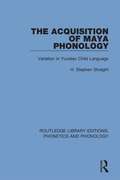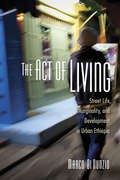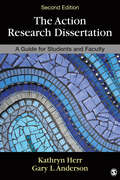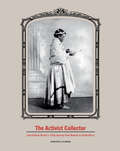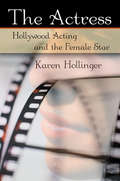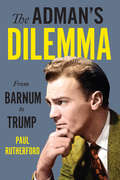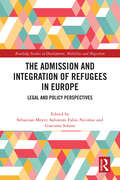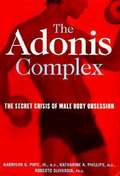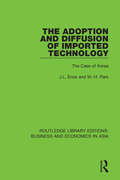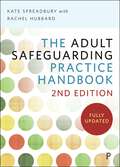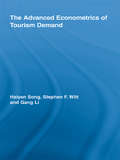- Table View
- List View
The Acquisition of Heritage Languages
by Montrul SilvinaHeritage speakers are native speakers of a minority language they learn at home, but due to socio-political pressure from the majority language spoken in their community, their heritage language does not fully develop. In the last decade, the acquisition of heritage languages has become a central focus of study within linguistics and applied linguistics. This work centres on the grammatical development of the heritage language and the language learning trajectory of heritage speakers, synthesizing recent experimental research. The Acquisition of Heritage Languages offers a global perspective, with a wealth of examples from heritage languages around the world. Written in an accessible style, this authoritative and up-to-date text is essential reading for professionals, students, and researchers of all levels working in the fields of sociolinguistics, psycholinguistics, education, language policies and language teaching.
The Acquisition of Maya Phonology: Variation in Yucatec Child Language (Routledge Library Editions: Phonetics and Phonology #21)
by H. Stephen StraightFirst published in 1976. This title presents a study of Yucatec Maya segmental phonology by children. The aim of the study is to describe the phonological systems revealed in the speech of group of children in order to determine the kinds of structural differences which exist among these pedolectal variants. This title will be of great interest to students of linguistics.
The Acropolis: Global Fame, Local Claim (Materializing Culture Ser.)
by Eleana YalouriThe Acropolis in Athens has captured the imaginations of readers, writers and travellers for centuries and every year draws crowds from all over the world. One of the world's most famous heritage sites, it has long been a national monument of Greece and a potent symbol of western civilization. But the Acropolis is typically viewed in the context of 5th-century-BC Athenian society, while the multiple local and international meanings and identities that the site shapes today are overlooked. This book looks at the meaning of the Acropolis in contemporary Greece. How are global ideas adopted and adapted by local cultures? How do Greeks deal with the national and international features of their ancient classical heritage? How do the global cultural constructions surrounding the Acropolis become part of local practices which project Greek cultural difference?The author examines this historic site as a powerful agent for negotiations of power on an international level. Drawing from a wide range of sources as well as original fieldwork, this handsomely illustrated book will make compelling reading for anyone interested in heritage issues, archaeology, anthropology material culture studies, and tourism.
The Act of Living: Street Life, Marginality, and Development in Urban Ethiopia
by Marco Di NunzioThe Act of Living explores the relation between development and marginality in Ethiopia, one of the fastest growing economies in Africa. Replete with richly depicted characters and multi-layered narratives on history, everyday life and visions of the future, Marco Di Nunzio's ethnography of hustling and street life is an investigation of what is to live, hope and act in the face of the failing promises of development and change. Di Nunzio follows the life trajectories of two men, "Haile" and "Ibrahim," as they grow up in the Ethiopian capital Addis Ababa, enter street life to get by, and turn to the city's expanding economies of work and entrepreneurship to search for a better life. Apparently favourable circumstances of development have not helped them achieve social improvement. As their condition of marginality endures, the two men embark in restless attempts to transform living into a site for hope and possibility.By narrating Haile and Ibrahim's lives, The Act of Living explores how and why development continues to fail the poor, how marginality is understood and acted upon in a time of promise, and why poor people's claims for open-endedness can lead to better and more just alternative futures. Tying together anthropology, African studies, political science, and urban studies, Di Nunzio takes readers on a bold exploration of the meaning of existence, hope, marginality, and street life.
The Action Research Dissertation: A Guide for Students and Faculty
by Gary Anderson Dr Kathryn G. HerrThe first edition of The Action Research Dissertation: A Guide for Students and Faculty was a first-of-its-kind reference, distilling the authors’ decades of action research experience into a handy guide for graduate students. The Second Edition continues to provide an accessible roadmap that honors the complexity of action research, while providing an overview of how action research is defined, its traditions and history, and the rationale for using it. Authors Kathryn Herr and Gary L. Anderson demonstrate that action research is not only appropriate for a dissertation, but also is a deeply rewarding experience for both the researcher and participants. This practical book demonstrates how action research dissertations are different from more traditional dissertations and prepares students and their committees for the unique dilemmas they may face, such as validity, positionality, design, write-up, ethics, and dissertation defense.
The Action and Adventure Cinema
by Yvonne TaskerThis exciting collection addresses action and adventure from the silent to the contemporary period exploring diverse questions of aesthetics, industry and ideology. Action has established itself as one of the leading commercial genres of the New Hollywood cinema, generating extensive debate in the process.Contributors consider how action might best be defined, how it has developed historically, and how it works formally. The critical reception and standing of action and adventure cinema is considered in relation to questions of national culture, violence and the 'art' of cinema.Themes explored include genre and definitions; early action, sensation and melodrama; authorship and action; national and transnational action-adventure traditions; action aesthetics; spectacle and narrative; stars and bodies; class; gender; race and ethnicity. Attempting to evaluate the significance of this type of filmmaking for both popular cinema and film studies, the book underlines the central place of action and adventure within film history.
The Active Archaeology Notebook (First Edition)
by Leah McCurdyThe Active Archaeology Notebook offers effective and fun activities for the archaeology classroom. Conceived by a team of instructors from the SAA Curriculum Committee under the direction of Leah McCurdy (University of Texas at Arlington), every activity has been class tested and is designed to demonstrate key concepts in archaeology. The Notebook is ideal for instructors looking for diverse and active ways to teach archaeology.
The Active Interview
by Jaber F. Gubrium Dr James A. HolsteinInterviews were once regarded as the pipeline through which information was transmitted from a passive subject to an omniscient researcher. However the new "active interview" considers interviewers and interviewees as equal partners in constructing meaning around an interview. This interpretation changes a range of elements in the interview process - from the way of conceiving a sample to the ways in which the interview may be conducted and the results analyzed. In this guide, the authors outline the differences between active and traditional interviews and give novice researchers clear guidelines on conducting a successful interview.
The Activist Collector: Lida Clanton Broner’s 1938 Journey from Newark to South Africa
by Christa Clarke“After twenty-eight years of desire and determination, I have visited Africa, the land of my forefathers.” So wrote Lida Clanton Broner (1895–1982), an African American housekeeper and hairstylist from Newark, New Jersey, upon her return from an extraordinary nine-month journey to South Africa in 1938. This epic trip was motivated not only by Broner’s sense of ancestral heritage, but also a grassroots resolve to connect the socio-political concerns of African Americans with those of black South Africans under the segregationist policies of the time. During her travels, this woman of modest means circulated among South Africa’s Black intellectual elite, including many leaders of South Africa’s freedom struggle. Her lectures at Black schools on “race consciousness and race pride” had a decidedly political bent, even as she was presented as an “American beauty specialist.” How did Broner—a working class mother—come to be a globally connected activist? What were her experiences as an African American woman in segregated South Africa and how did she further her work after her return? Broner’s remarkable story is the subject of this book, which draws upon a deep visual and documentary record now held in the collection of the Newark Museum of Art. This extraordinary archive includes more than one hundred and fifty objects, ranging from beadwork and pottery to mission school crafts, acquired by Broner in South Africa, along with her diary, correspondence, scrapbooks, and hundreds of photographs with handwritten notations. Published by the Newark Museum. Distributed worldwide by Rutgers University Press.
The Actress: Hollywood Acting and the Female Star
by Karen HollingerThe Actress: Hollywood Acting and the Female Star investigates the contemporary film actress both as an artist and as an ideological construct. Divided into two sections, The Actress first examines the major issues in studying film acting, stardom, and the Hollywood actress. Combining theories of screen acting and of film stardom, The Actress presents a synthesis of methodologies and offers the student and scholar a new approach to these two subjects of study.
The Actual and the Rational: Hegel and Objective Spirit
by Jean-François KervéganOne of Hegel’s most controversial and confounding claims is that “the real is rational and the rational is real.” In this book, one of the world’s leading scholars of Hegel, Jean-François Kervégan, offers a thorough analysis and explanation of that claim, along the way delivering a compelling account of modern social, political, and ethical life. ?Kervégan begins with Hegel’s term “objective spirit,” the public manifestation of our deepest commitments, the binding norms that shape our existence as subjects and agents. He examines objective spirit in three realms: the notion of right, the theory of society, and the state. In conversation with Tocqueville and other theorists of democracy, whether in the Anglophone world or in Europe, Kervégan shows how Hegel—often associated with grand metaphysical ideas—actually had a specific conception of civil society and the state. In Hegel’s view, public institutions represent the fulfillment of deep subjective needs—and in that sense, demonstrate that the real is the rational, because what surrounds us is the product of our collective mindedness. This groundbreaking analysis will guide the study of Hegel and nineteenth-century political thought for years to come.
The Adaptation Industry: The Cultural Economy of Contemporary Literary Adaptation (Routledge Research in Cultural and Media Studies)
by Simone MurrayAdaptation constitutes the driving force of contemporary culture, with stories adapted across an array of media formats. However, adaptation studies has been concerned almost exclusively with textual analysis, in particular with compare-and-contrast studies of individual novel and film pairings. This has left almost completely unexamined crucial questions of how adaptations come to be made, what are the industries with the greatest stake in making them, and who the decision-makers are in the adaptation process. The Adaptation Industry re-imagines adaptation not as an abstract process, but as a material industry. It presents the adaptation industry as a cultural economy of six interlocking institutions, stakeholders and decision-makers all engaged in the actual business of adapting texts: authors; agents; publishers; book prize committees; scriptwriters; and screen producers and distributors. Through trading in intellectual property rights to cultural works, these six nodal points in the adaptation network are tightly interlinked, with success for one party potentially auguring for success in other spheres. But marked rivalries between these institutional forces also exist, with competition characterizing every aspect of the adaptation process. This book constructs an overdue sociology of contemporary literary adaptation, never losing sight of the material and institutional dimensions of this powerful process.
The Addictive Behaviors
by Barry Stimmel Howard J ShafferThoroughly examines the natural history and social etiology of addictive behaviors.
The Address Book: What Street Addresses Reveal About Identity, Race, Wealth, and Power
by Deirdre MaskAn extraordinary debut in the tradition of classic works from authors such as Mark Kurlansky, Mary Roach, and Rose George.An exuberant and insightful work of popular history of how streets got their names, houses their numbers, and what it reveals about class, race, power, and identity.When most people think about street addresses, if they think of them at all, it is in their capacity to ensure that the postman can deliver mail or a traveler won’t get lost. But street addresses were not invented to help you find your way; they were created to find you. In many parts of the world, your address can reveal your race and class. In this wide-ranging and remarkable book, Deirdre Mask looks at the fate of streets named after Martin Luther King Jr., the wayfinding means of ancient Romans, and how Nazis haunt the streets of modern Germany. The flipside of having an address is not having one, and we also see what that means for millions of people today, including those who live in the slums of Kolkata and on the streets of London. Filled with fascinating people and histories, The Address Book illuminates the complex and sometimes hidden stories behind street names and their power to name, to hide, to decide who counts, who doesn’t—and why.
The Adman’s Dilemma: From Barnum to Trump
by Paul RutherfordThe Adman’s Dilemma is a cultural biography that explores the rise and fall of the advertising man as a figure who became effectively a licensed deceiver in the process of governing the lives of American consumers. Apparently this personage was caught up in a contradiction, both compelled to deceive yet supposed to tell the truth. It was this moral condition and its consequences that made the adman so interesting to critics, novelists, and eventually filmmakers. The biography tracks his saga from its origins in the exaggerated doings of P.T. Barnum, the emergence of a new profession in the 1920s, the heyday of the adman’s influence during the post-WW2 era, the later rebranding of the adman as artist, until the apparent demise of the figure, symbolized by the triumph of that consummate huckster, Donald Trump. In The Adman’s Dilemma, author Paul Rutherford explores how people inside and outside the advertising industry have understood the conflict between artifice and authenticity. The book employs a range of fictional and nonfictional sources, including memoirs, novels, movies, TV shows, websites, and museum exhibits to suggest how the adman embodied some of the strange realities of modernity.
The Admission and Integration of Refugees in Europe: Legal and Policy Perspectives (Routledge Studies in Development, Mobilities and Migration)
by Sebastian Meyer Salvatore Fabio Nicolosi Giacomo SolanoThe Admission and Integration of Refugees in Europe argues for a more interconnected understanding of laws and policies for the admission and integration of refugees and asylum seekers in the European Union.Admission and integration normally refer to different phases of the migratory process, but this demonstrates that they are inherently interconnected. Certain legal statuses conferred in admission procedures are directly relevant for the integration prospects of migrants, and the success or failure to integrate has potential repercussions for residence rights, although refugees are in that respect better protected than other immigrants. Legal pluralism further complicates the European context, as admission is often seen as under European Union jurisdiction, and integration as a Member State consideration. However, the book argues that this legal pluralism in fact helps us to better explain how interaction between admission and integration takes place across laws and legal orders. Combining broad conceptual and constitutional analysis with closer readings of specific policies and country-specific case studies, this book demonstrates the potential for specific admission policies to either promote or hinder integration.This book will be an important contribution to debates on European asylum and refugee law, human rights, and migrant integration policy.
The Adonis Complex: The Secret Crisis of Male Body Obsession
by Jr. Harrison G. Pope Katharine A. Phillips Roberto OlivardiaDiscusses the growing numbers of men who are taking the quest for perfect muscles, skin, and hair too far, crossing the line from normal interest to pathological obsession.
The Adopted Child Comes of Age (National Institute Social Services Library)
by Lois RaynorHow do adoptions really turn out? How do adopted children feel about the family they were given and the opportunities they were offered? To what extent do they fulfil their new parents’ expectations of them? And does it matter whether their adoption grew out of a fostering relationship or was considered right from the start as a permanent arrangement? Originally published in 1980, the major follow-up study on which this book is based sought to answer these questions. The research involved 160 sets of parents and over 100 of their adopted children, now young adults. This was, in fact, the largest group of adult adoptees anywhere in the world to be interviewed and studied in a systematic way. As they look back over their life together, the parents and the young people explain what adopting or being adopted was like for them. This title offers glimpses of adoptive family life over a period of more than twenty years, compares the views of the young people with those of their adopters and measures the factors which influenced the various outcomes. Particular attention is paid to the basis on which the child was originally placed, in order to shed light on the controversial subject, at the time, of whether a preliminary fostering period represents a useful safeguard. The information gathered by Lois Raynor and her colleagues provided the feedback so long sought by social work teachers and by those practising social workers who had the responsibility for making long-term plans for children and for approving foster home or adoption applications at the time. Readers with personal experience of adoption will be interested in making their own comparisons, while prospective adopters will learn to avoid some pitfalls and to enjoy an adopted child as their own.
The Adoption and Diffusion of Imported Technology: The Case of Korea (Routledge Library Editions: Business and Economics in Asia #2)
by J.L. Enos W.-H. ParkThis book, first published in 1988, considers the problems that developing countries face when importing technology from abroad. The major issues - technical, economic, political - are analysed in the case of one particular country: Korea. The book describes the negotiations with the foreign companies that controlled the desired technology, the building of the plants, the training of engineers and managers to replace expatriots, the improvements of processes and products and the maintenance of efficient and profitable production. In their research the authors were given access to information usually kept confidential - government memoranda and minutes, company contacts and records, costs and prices. The book also considers how typical of the developing countries Korea is, and the authors make certain policy recommendations for the future.
The Adoring Audience: Fan Culture and Popular Media
by Lisa A. LewisWith stories of hysterical teenagers and obsessive fans killing for their heroes, fans and fandom get a bad press. The Adoring Audience looks deeper into fan culture, particularly as it relates to identity, sexuality and textual production.
The Adult Safeguarding Practice Handbook
by Rachel Hubbard Kate SpreadburyThis is an essential, practical guide to best practice in adult safeguarding which supports students and practitioners to develop the skills, knowledge and ethical awareness to confidently address the challenges of adult safeguarding across a wide range of practice contexts in the UK. The authors explore the current context of adult safeguarding in the UK, together with the legislation, rights and principles that are the basis of best practice, and with a focus on developments in practice following the implementation of the Care Act (2014). Practitioners are supported to develop their practice by exploring new research and innovative ways of working within the field, while promoting the importance of learning from experience and building resilience in adult safeguarding work. This book includes: • helpful case studies and examples of professional decision making from experienced adult safeguarding practitioners • top tips and models to enable confident application of knowledge to practice • tools for reflection to extend the practitioner’s development
The Adult Safeguarding Practice Handbook 2e
by Kate SpreadburyThe second edition of this best-selling book provides an essential guide to best practice in adult safeguarding. It has been updated to include recent legislative, guidance and research-based developments and relates them to useful practice examples. Featuring new support materials and key case studies, it includes: • a focus on working with marginalised groups under the safeguarding and prevention duties, including ‘transitional’ safeguarding; • an exploration of best practice in light of changes to national guidance and research; • findings from a range of Safeguarding Adults Reviews with reflections on the outcomes of two national (England) Safeguarding Review Audits; and • an expansion of the concepts of professional curiosity and trauma-informed/-aware approaches. Students and practitioners are guided to reflect on practice and to extend their skills, knowledge and values to become confident and competent in the complex area of adult safeguarding.
The Advanced Econometrics of Tourism Demand (Routledge Advances In Tourism Ser.)
by Gang Li Haiyan Song Stephen F. WittTourism demand is the foundation on which all tourism-related business decisions ultimately rest. Governments and companies such as airlines, tour operators, hotels, cruise ship lines, and recreation facility providers are interested in the demand for their products by tourists. The success of many businesses depends largely or totally on the state
The Advanced Genius Theory: Are They Out of Their Minds or Ahead of Their Time?
by Jason HartleyLet the debate begin The Advanced Genius Theory, hatched by Jason Hartley and Britt Bergman over pizza, began as a means to explain why icons such as Lou Reed, David Bowie, and Sting seem to go from artistic brilliance in their early careers to "losing it" as they grow older. The Theory proposes that they don't actually lose it, but rather, their work simply advances beyond our comprehension. The ramifications and departures of this argument are limitless, and so are the examples worth considering, such as George Lucas's Jar Jar Binks, Stanley Kubrick's fascination with coffee commercials, and the last few decades of Paul McCartney's career. With equal doses of humor and philosophy, theorist Jason Hartley examines music, literature, sports, politics, and the very meaning of taste, presenting an entirely new way to appreciate the pop culture we love . . . and sometimes think we hate. The Advanced Genius Theory is a manifesto that takes on the least understood work by the most celebrated figures of our time.
The Adventure of Relevance
by Martin SavranskyAt a time where the relevance of the social sciences is under threat, this innovative book offers a speculative experimentation on the philosophy and methodology of the social sciences to rethink what 'relevance' is, and to cultivate a new ethos of knowledge-making for an eventful world. Engaging a diverse a range of thinkers including Alfred North Whitehead, Gilles Deleuze and Isabelle Stengers, as well as the American pragmatists John Dewey and William James, Martin Savransky challenges longstanding assumptions in the social sciences and argues that relevance is an event that is part and parcel of the immanent and situated processes by which things come to matter. He develops new conceptual tools for cultivating an empiricist ethos of inquiry that is attuned to the question of how things come to matter- an ethics that turns social inquiry into a veritable adventure. The result is an original and rigorous book that infuses knowledge-practices in the social sciences with new sensibilities, creative possibilities, and novel habits of thinking, knowing, and feeling.

